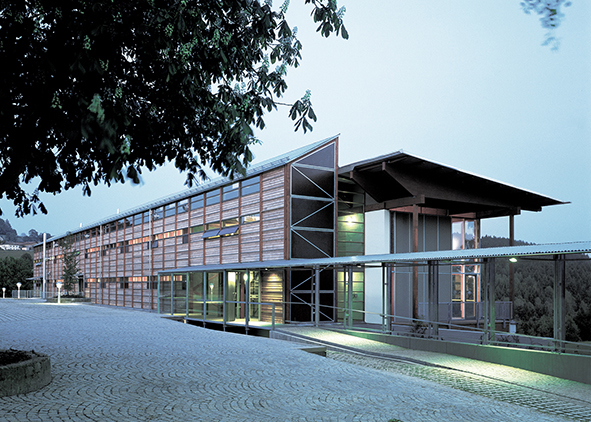Su flessibilità e sostenibilità del progetto. Riflessioni personali e prospettive
DOI:
https://doi.org/10.19229/2464-9309/822020Parole chiave:
zonizzazione, flessibilità, forma prestazionale, facciate verdi, biofiliaAbstract
La maggior parte dell’umanità vivrà in futuro nelle megalopoli, città che hanno coscienza dell’importanza del legame tra la qualità della vita e gli spazi a verde. Tuttavia, sebbene le facciate verdi influenzino molti parametri di un edificio, la ‘biofilia’ è raramente un obiettivo di progetto. Gli effetti della vegetazione sul microclima degli edifici possono essere rilevanti e migliorare la sensazione di benessere degli utenti; per questo motivo la vegetazione dovrebbe essere assimilata a un subsistema edilizio e presa in debita considerazione nella progettazione degli edifici del futuro. L’Architettura si occupa anche dello spirito di un luogo, dei manufatti che in esso si insediano e dei loro subsistemi durante cicli diversi e fasi temporali differenti. Considerare i cambiamenti di uso e delle funzioni dello spazio costruito, concentrandosi al tempo stesso sull’edilizia sostenibile e sulle energie rinnovabili, amplifica le potenzialità di una ‘forma prestazionale’ con una qualità architettonica specifica.
Downloads
##plugins.generic.articleMetricsGraph.articlePageHeading##
Riferimenti bibliografici
Arup (2016), Cities Alive – Green Building Envelope. [Online] Available at: www.arup.com/perspectives/publications/research/section/cities-alive-green-building-envelope [Accessed 14 November 2020].
Bratman, G. N., Hamilton, J. P. and Daily, G. C. (2012), “The impacts of nature experience on human cognitive function and mental health”, in Annals of the New York Academy of Sciences, vol. 1249, issue 1, pp. 118-136. [Online] Available at: doi.org/10.1111/j.1749-6632.2011.06400.x [Accessed 14 November 2020].
Brod, C. (1984), Technostress – The human cost of computer revolution, Addison-Wesley, Reading.
Cytowic, R. E. and Eagleman, D. M. (2009), Wednesday is indigo blue – Discovering the brain of synesthesia, MIT Press, Cambridge-London.
Fromm, E. (1973), The anatomy of human destructiveness, Fawcett, New York.
Gobster, P. H., Nassauer, J. I., Daniel, T. C. and Fry, G. (2007), “The shared landscape – What does aesthetics have to do with ecology?”, in Landscape Ecology, vol. 22, issue 7, pp. 959-972. [Online] Available at: doi.org/10.1007/s10980-007-9110-x [Accessed 14 November 2020].
Herzog, T. (1992), Thomas Herzog – Bauten, 1978-1992 – Ein Werkbericht | Buildings, 1978-1992 – A working report, G. Hatje, Stuttgart.
Herzog, T., Flagge, I., Herzog-Loibl, V. and Meseure, A. (2002), Thomas Herzog – Architektur + Technologie | Architecture + Technology, Prestel, Munchen-New York.
Kaplan, R. and Kaplan, S. (2011), “Well-being, Reasonableness, and the Natural Environment”, in Applied Psychology – Health and Well-Being, vol. 3, issue 3, pp. 304-321. [Online] Available at: doi.org/10.1111/j.1758-0854.2011.01055.x [Accessed 14 November 2020].
Kaplan, R. and Kaplan, S. (1989), The experience of nature – A psychological perspective, Cambridge University Press, Cambridge-New York.
Kuo, F. E. and Sullivan, W. C. (2001), “Aggression and Violence in the Inner City – Effects of Environment via Mental Fatigue”, in Environment and Behavior, vol. 33, issue 4, pp. 543-571. [Online] Available at: doi.org/10.1177/00139160121973124 [Accessed 14 November 2020].
Kuo, M. (2015), “How might contact with nature promote human health? Promising mechanisms and a possible central pathway”, in Frontiers in Psychology, vol. 6, article 1093. [Online] Available at: doi.org/10.3389/fpsyg.2015.01093 [Accessed 14 November 2020].
Louv, R. (2008), Last child in the woods – Saving our children from nature-deficit disorder, Algonquin Books of Chapel Hill, Chapel Hill (NC).
Miyazaki, Y. (2018), Shinrin-yoku – La teoria giapponese del bagno nella foresta per ritrovare il proprio equilibrio, Gribaudo, Milano.
Pallasmaa, J. (2012), The eyes of the skin – Architecture and the senses, Wiley, Chichester
Pauli, M. and Scheuermann, R. (2017), “Messbare Vorteile von Fassadenbegrünungen | Measurable benefits of green facades”, in Detail, vol. 01/2017, pp. 48-55. [Online] Available at: issuu.com/detail-magazine/docs/bk_green_2017-1-det-dee/8 [Accessed 14 November 2020].
Taylor, A. F., Kuo, F. E. and Sullivan, W. C. (2002), “Views of Nature and Self-discipline – Evidence from inner city children”, in Journal of Environmental Psychology, vol. 22, issues 1-2, pp. 49-63. [Online] Available at: doi.org/10.1006/jevp.2001.0241 [Accessed 14 November 2020].
Teilhard de Chardin, P. (1959), The phenomenon of man [or. ed. Le phénomène humain, 1955], Harper and Row Publisher, New York. [Online] Available at: collopy.net/teaching/2017/evolution/readings/The%20 Phenomenon%20of%20Man.pdf [Accessed 14 November 2020].
Tennessen, C. M. and Cimprich, B. (1995), “Views to nature – Effects on attention”, in Journal of Environmental Psychology, vol. 15, issue 1, pp. 77-85. [Online] Available at: doi.org/10.1016/0272-4944(95)90016-0 [Accessed 14 November 2020].
Ulrich, R. S., Bogren, L. and Lundin, S. (2012), “Towards a design theory for reducing aggression in psychiatric facilities”, in ARCH12 – Architecture / Research / Care / Health Perspectives on Nordic Welfare Environments, Chalmers, Gothenburg, November 12-14, 2012, pp. 1-12. [Online] Available at: conferences.chalmers.se/index.php/ARCH/arch12/paper/view/426/67 [Accessed 14 November 2020].
UN – United Nations (2019), World Population Prospects 2019 – Highlights. [Online] Available at: population.un.org/wpp/Publications/Files/WPP2019_Highlights.pdf [Accessed 14 November 2020].
Wilson, E. O. (1984), Biophilia – The human bond with other species, Harvard University Press, Cambridge.

##submission.downloads##
Pubblicato
Come citare
Fascicolo
Sezione
Licenza
AGATHÓN è pubblicata sotto la licenza Creative Commons Attribution License 4.0 (CC-BY).
License scheme | Legal code
Questa licenza consente a chiunque di:
Condividere: riprodurre, distribuire, comunicare al pubblico, esporre in pubblico, rappresentare, eseguire e recitare questo materiale con qualsiasi mezzo e formato.
Modificare: remixare, trasformare il materiale e basarti su di esso per le tue opere per qualsiasi fine, anche commerciale.
Alle seguenti condizioni
Attribuzione: si deve riconoscere una menzione di paternità adeguata, fornire un link alla licenza e indicare se sono state effettuate delle modifiche; si può fare ciò in qualsiasi maniera ragionevole possibile, ma non con modalità tali da suggerire che il licenziante avalli l'utilizzatore o l'utilizzo del suo materiale.
Divieto di restrizioni aggiuntive: non si possono applicare termini legali o misure tecnologiche che impongano ad altri soggetti dei vincoli giuridici su quanto la licenza consente di fare.
Note
Non si è tenuti a rispettare i termini della licenza per quelle componenti del materiale che siano in pubblico dominio o nei casi in cui il nuovo utilizzo sia consentito da una eccezione o limitazione prevista dalla legge.
Non sono fornite garanzie. La licenza può non conferire tutte le autorizzazioni necessarie per l'utilizzo che ci si prefigge. Ad esempio, diritti di terzi come i diritti all'immagine, alla riservatezza e i diritti morali potrebbero restringere gli usi del materiale.


















































































